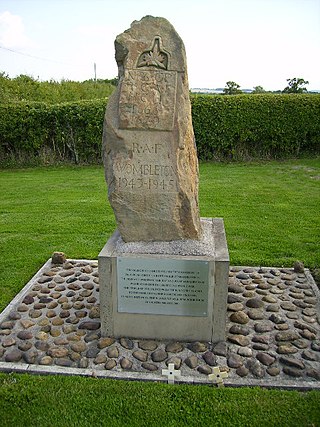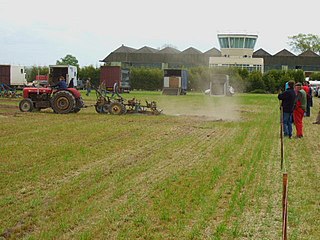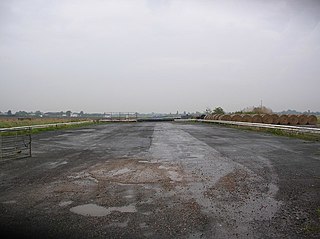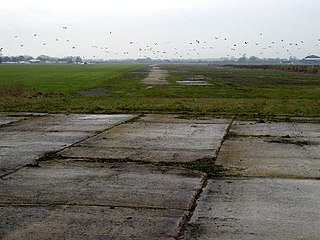
Royal Air Force Leeming or RAF Leeming is a Royal Air Force (RAF) station located near Leeming, North Yorkshire, England. It was opened in 1940 and was jointly used by the RAF and the Royal Canadian Air Force (RCAF). Between 1950 and 1991, it operated mostly as a training base with Quick Reaction Force (QRF) Panavia Tornado F3 fighters based there in the latter stages of the Cold War and into the early 21st century. Since 2006, it has become the home of the deployable RAF communications cadre and the home of No. 135 Expeditionary Air Wing.

Royal Air Force Dishforth or more simply RAF Dishforth is a former Royal Air Force station near to Ripon in North Yorkshire, England. Opened in 1936, the base was used as a bomber airfield during the Second World War with both British and Canadian squadrons flying missions from the airfield. After the war, the base was used by various squadrons and training units before being disposed of in 1992 and handed over to the Army Air Corps.

Royal Air Force Leconfield or more simply RAF Leconfield is a former Royal Air Force station located in Leconfield, East Riding of Yorkshire, England.

Royal Air Force Station Wombleton or RAF Wombleton is a former Royal Air Force station located 3.8 miles (6.1 km) east of Helmsley, North Yorkshire and 11.8 miles (19 km) north east of Easingwold, North Yorkshire, England.

Royal Air Force Scorton or more simply RAF Scorton is a former Royal Air Force satellite station located next to the village of Scorton in North Yorkshire, England. The base was opened in October 1939 as part of 13 Group RAF Fighter Command and a satellite station of RAF Catterick. It was used by the Royal Air Force, the Royal Canadian Air Force, and the United States Army Air Forces Ninth Air Force during the war.

Royal Air Force Station Lindholme or more simply RAF Lindholme is a former Royal Air Force station in South Yorkshire, England. It was located 3.9 miles (6.3 km) south of Thorne and 6.9 miles (11.1 km) north east of Doncaster and was initially called RAF Hatfield Woodhouse.
Royal Air Force Full Sutton or RAF Full Sutton is a former Royal Air Force station located 2 miles (3.2 km) south east of Stamford Bridge, East Riding of Yorkshire and 4.7 miles (7.6 km) north west of Pocklington, East Riding of Yorkshire, England. The base did not open until May 1944, and so was the last airfield built for Bomber Command.

RAF Marston Moor was a Royal Air Force airfield at Tockwith, North Yorkshire, during the Second World War. It was originally called RAF Tockwith, but confusion with RAF Topcliffe led to the name change.
Royal Air Force Station Lissett or more simply RAF Lissett is a former Royal Air Force station located 6.1 miles (9.8 km) south west of Bridlington, East Riding of Yorkshire, England.

Royal Air Force Melbourne or more simply RAF Melbourne is a former Royal Air Force station used during the Second World War. Located 5 miles (8 km) to the south-west of Pocklington, Yorkshire, England. The nearest village is Seaton Ross.

Royal Air Force Burn or more simply RAF Burn is a former Royal Air Force satellite station located 5 miles (8 km) south of Selby and 0.5 miles (0.8 km) east of Burn in North Yorkshire, England which opened in 1942 before closing in 1946.

RAF Pocklington was an operational flying station of the Royal Air Force during the Second World War, forming part of Bomber Command, and operating primarily Wellington and Halifax bombers. The station, adjacent to the town of Pocklington at grid reference SE790485, opened in 1941, and was closed in 1946. After a return to agricultural use, the station now forms an industrial estate and a restricted use airfield for a gliding club.
Royal Air Force Doncaster or more simply RAF Doncaster, also referred to as Doncaster Aerodrome, is a former Royal Air Force station near Doncaster, South Yorkshire, England.

RAF Holme-on-Spalding Moor, or more simply RAF Holme is a former Royal Air Force station located in the East Riding of Yorkshire, England.

Royal Air Force Cottam or more simply RAF Cottam is a former Royal Air Force satellite airfield near Cottam in the East Riding of Yorkshire, England and 3.9 miles (6.3 km) north west of Driffield, East Riding of Yorkshire. The airfield was used only occasionally for flying, mostly being utilised as a bomb storage site.

Royal Air Force Hutton Cranswick or more simply RAF Hutton Cranswick is a former Royal Air Force station located to the south of Driffield and immediately south west of the village of Hutton Cranswick in the East Riding of Yorkshire, England. The station was developed as a fighter base with many Spitfire fighter squadrons passing through. It was used by the Royal Air Force, the Royal Canadian Air Force (RCAF), and several Polish Fighter Squadrons of the RAF. It was opened in 1942, and disposed of in 1946.
RAF Riccall is a former Royal Air Force airfield located 3.1 miles (5 km) north east of Selby, North Yorkshire and 7.9 miles (12.7 km) south west of Elvington, North Yorkshire, England.

Royal Air Force Church Fenton or RAF Church Fenton was a former Royal Air Force (RAF) station located 4.3 miles (6.9 km) south east of Tadcaster, North Yorkshire, England and 6.3 miles (10.1 km) north west of Selby, North Yorkshire, near the village of Church Fenton. The station was opened in 1937 and during the Second World War was home to air defence aircraft, a role retained by the station until the 1960s when it became a training station. It closed in 2013 and is now a civilian airfield known as Leeds East Airport.

Royal Air Force Shipton was a First World War era airfield located north of the village of Shipton-by-Beningbrough, in North Yorkshire, England. During the First World War, it was used by No. 76 Squadron RAF whose remit was to provide Home Defence (HD).



















